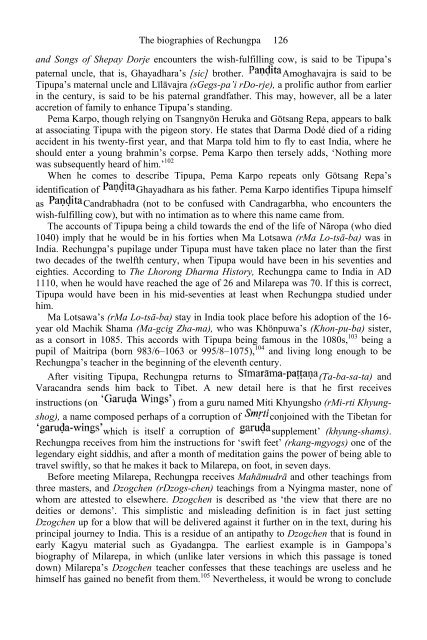The Biographies of Rechungpa: The Evolution of a Tibetan ...
The Biographies of Rechungpa: The Evolution of a Tibetan ...
The Biographies of Rechungpa: The Evolution of a Tibetan ...
You also want an ePaper? Increase the reach of your titles
YUMPU automatically turns print PDFs into web optimized ePapers that Google loves.
<strong>The</strong> biographies <strong>of</strong> <strong>Rechungpa</strong> 126<br />
and Songs <strong>of</strong> Shepay Dorje encounters the wish-fulfilling cow, is said to be Tipupa’s<br />
paternal uncle, that is, Ghayadhara’s [sic] brother. Amoghavajra is said to be<br />
Tipupa’s maternal uncle and Līlāvajra (sGegs-pa’i rDo-rje), a prolific author from earlier<br />
in the century, is said to be his paternal grandfather. This may, however, all be a later<br />
accretion <strong>of</strong> family to enhance Tipupa’s standing.<br />
Pema Karpo, though relying on Tsangnyön Heruka and Götsang Repa, appears to balk<br />
at associating Tipupa with the pigeon story. He states that Darma Dodé died <strong>of</strong> a riding<br />
accident in his twenty-first year, and that Marpa told him to fly to east India, where he<br />
should enter a young brahmin’s corpse. Pema Karpo then tersely adds, ‘Nothing more<br />
was subsequently heard <strong>of</strong> him.’ 102<br />
When he comes to describe Tipupa, Pema Karpo repeats only Götsang Repa’s<br />
identification <strong>of</strong> Ghayadhara as his father. Pema Karpo identifies Tipupa himself<br />
as Candrabhadra (not to be confused with Candragarbha, who encounters the<br />
wish-fulfilling cow), but with no intimation as to where this name came from.<br />
<strong>The</strong> accounts <strong>of</strong> Tipupa being a child towards the end <strong>of</strong> the life <strong>of</strong> Nāropa (who died<br />
1040) imply that he would be in his forties when Ma Lotsawa (rMa Lo-tsā-ba) was in<br />
India. <strong>Rechungpa</strong>’s pupilage under Tipupa must have taken place no later than the first<br />
two decades <strong>of</strong> the twelfth century, when Tipupa would have been in his seventies and<br />
eighties. According to <strong>The</strong> Lhorong Dharma History, <strong>Rechungpa</strong> came to India in AD<br />
1110, when he would have reached the age <strong>of</strong> 26 and Milarepa was 70. If this is correct,<br />
Tipupa would have been in his mid-seventies at least when <strong>Rechungpa</strong> studied under<br />
him.<br />
Ma Lotsawa’s (rMa Lo-tsā-ba) stay in India took place before his adoption <strong>of</strong> the 16year<br />
old Machik Shama (Ma-gcig Zha-ma), who was Khönpuwa’s (Khon-pu-ba) sister,<br />
as a consort in 1085. This accords with Tipupa being famous in the 1080s, 103 being a<br />
pupil <strong>of</strong> Maitripa (born 983/6–1063 or 995/8–1075), 104 and living long enough to be<br />
<strong>Rechungpa</strong>’s teacher in the beginning <strong>of</strong> the eleventh century.<br />
After visiting Tipupa, <strong>Rechungpa</strong> returns to (Ta-ba-sa-ta) and<br />
Varacandra sends him back to Tibet. A new detail here is that he first receives<br />
instructions (on ) from a guru named Miti Khyungsho (rMi-rti Khyungshog),<br />
a name composed perhaps <strong>of</strong> a corruption <strong>of</strong> conjoined with the <strong>Tibetan</strong> for<br />
which is itself a corruption <strong>of</strong> supplement’ (khyung-shams).<br />
<strong>Rechungpa</strong> receives from him the instructions for ‘swift feet’ (rkang-mgyogs) one <strong>of</strong> the<br />
legendary eight siddhis, and after a month <strong>of</strong> meditation gains the power <strong>of</strong> being able to<br />
travel swiftly, so that he makes it back to Milarepa, on foot, in seven days.<br />
Before meeting Milarepa, <strong>Rechungpa</strong> receives Mahāmudrā and other teachings from<br />
three masters, and Dzogchen (rDzogs-chen) teachings from a Nyingma master, none <strong>of</strong><br />
whom are attested to elsewhere. Dzogchen is described as ‘the view that there are no<br />
deities or demons’. This simplistic and misleading definition is in fact just setting<br />
Dzogchen up for a blow that will be delivered against it further on in the text, during his<br />
principal journey to India. This is a residue <strong>of</strong> an antipathy to Dzogchen that is found in<br />
early Kagyu material such as Gyadangpa. <strong>The</strong> earliest example is in Gampopa’s<br />
biography <strong>of</strong> Milarepa, in which (unlike later versions in which this passage is toned<br />
down) Milarepa’s Dzogchen teacher confesses that these teachings are useless and he<br />
himself has gained no benefit from them. 105 Nevertheless, it would be wrong to conclude











